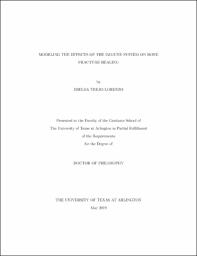
ATTENTION: The works hosted here are being migrated to a new repository that will consolidate resources, improve discoverability, and better show UTA's research impact on the global community. We will update authors as the migration progresses. Please see MavMatrix for more information.
Show simple item record
| dc.contributor.advisor | Kojouharov, Hristo | |
| dc.creator | Trejo Lorenzo, Imelda | |
| dc.date.accessioned | 2019-05-28T22:47:17Z | |
| dc.date.available | 2019-05-28T22:47:17Z | |
| dc.date.created | 2019-05 | |
| dc.date.issued | 2019-05-14 | |
| dc.date.submitted | May 2019 | |
| dc.identifier.uri | http://hdl.handle.net/10106/28156 | |
| dc.description.abstract | Bone fracture healing is a complex biological process that results in a full reconstruction of the bone. However, it is not always an easy and successful process. Indeed, in some unfavorable conditions, the bone fracture healing fails with approximately 10% of fractures resulting in nonunion. Furthermore, the risk of nonunion healing increases with age, severe trauma, and immune deficiency. In addition, clinical consequences of fractures include surgical management, prolonged hospitalization, and rehabilitation resulting in high socioeconomic costs. A better understanding of bone healing would enable to find optimal conditions for successful outcomes and to develop strategies for fracture treatments under normal or pathological scenarios.
Immune cells and their released molecular factors play a key role for successful bone healing. During bone fracture healing, the immune system cells clear up debris and regulate tissue cellular functions: proliferation, differentiation, and tissue production. However, the exact mechanisms and functions of the immune cells present at the fracture site are still not completely understood. Prolonged and chronic participation of the immune cells during the inflammation phase results in delayed union or nonunion healing, while depletion of them results in delayed bone formation. Therefore, for successful bone healing, the participation of immune cells in the healing process must be brief and well regulated.
In this work, several new mathematical models are presented that describe the process of bone fracture healing. The models incorporate complex interactions between immune cells and bone cells at the fracture site. The resulting systems of nonlinear ordinary differential equations are studied analytically and numerically. Mathematical conditions for successful bone fracture repairs are formulated. The models are used to numerically monitor the evolution of broken bones for different types of fractures and to explore possible treatments that can accelerate the bone fracture healing process. | |
| dc.format.mimetype | application/pdf | |
| dc.language.iso | en_US | |
| dc.subject | Bone fracture | |
| dc.subject | Immune system | |
| dc.subject | Modeling | |
| dc.title | MODELING THE EFFECTS OF THE IMMUNE SYSTEM ON BONE FRACTURE HEALING | |
| dc.type | Thesis | |
| dc.contributor.committeeMember | Liao, Guojun | |
| dc.degree.department | Mathematics | |
| dc.degree.name | Doctor of Philosophy in Mathematics | |
| dc.date.updated | 2019-05-28T22:47:17Z | |
| thesis.degree.department | Mathematics | |
| thesis.degree.grantor | The University of Texas at Arlington | |
| thesis.degree.level | Doctoral | |
| thesis.degree.name | Doctor of Philosophy in Mathematics | |
| dc.type.material | text | |
Files in this item
- Name:
- TREJOLORENZO-DISSERTATION-2019.pdf
- Size:
- 960.7Kb
- Format:
- PDF
This item appears in the following Collection(s)
Show simple item record


